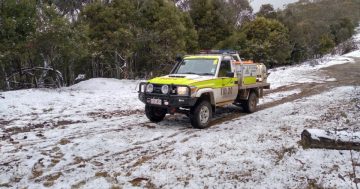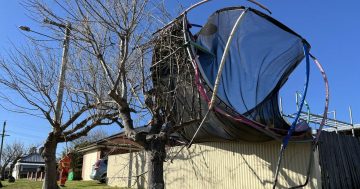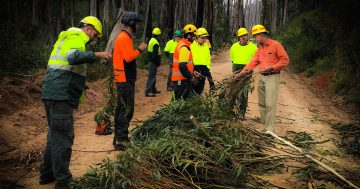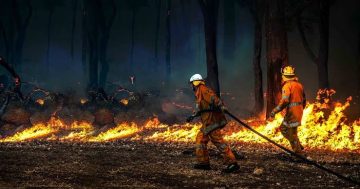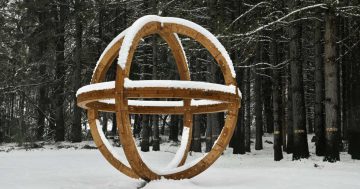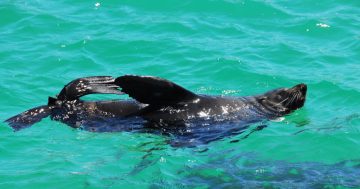
Summer daisies growing under the Snow Gums in Namadgi National Park. Photo: Ian Fraser.
On Australia Day I went up early into the Brindabellas to do some bird watching and generally enjoy the bush.
I drove from the lower wet forests along Lees Creek up to the wonderful Snow Gum woodlands along the ridge of the Brindabellas, looking out over the Goodradigbee River in New South Wales to the northern end of Kosciuszko National Park.
On my way down I was at amazed how many vehicles I passed heading up into the mountains, sometimes in groups of three or four. (I’ve been going up there for decades and don’t recall seeing such a parade).
I imagine that some of them were intending to cross the ranges and go down into New South Wales, but I like to think that at least some of them were going to spend the day among the Brindabella Snow Gums.

Snow Gums growing right at the tree line limit. Photo: Ian Fraser.
The woodlands of Snow Gums (Eucalyptus pauciflora) form a band of trees with a rich understorey of shrubs and wildflowers across the higher parts of the south-eastern Australian Alps, including of course the Brindabellas in Namadgi National Park.
The scientific name is a travesty – pauciflora means ‘sparse-flowering’ and a Snow Gum covered in white blossom is certainly not that. I assume that the specimens supplied by Czech-born collector Franz Sieber to the early 19thcentury German botanist Kurt Sprengel, who bestowed the name, either just happened to have not many flowers, or they got damaged in transit – that certainly happened to many other shipments. Either way he made an unfortunate assumption that has lasted.
No Australian tree grows at higher elevations. The tree line in our part of the world is at about 1800 metres. Above that the mean temperature, even of the warmest month, is simply not enough to provide the energy to build and support the massive trunks and roots needed for a tree to form and survive. Higher than that, only herbs and ground covers can hang in all year round but the Snow Gums push the limit, and can and do live with snow on the ground and piled on them for at least part of each winter.
Snow specialist Northern Hemisphere trees, especially various species of conifers, tend to have steeply sloping foliage and small leaves to shed the snow. Snow Gums have not adopted this strategy and snow accumulates on rigid branches and even on the big leathery leaves which resist freezing. The limbs are clearly very strong as Snow Gums hundreds of years old stand with unbroken stiff branches.
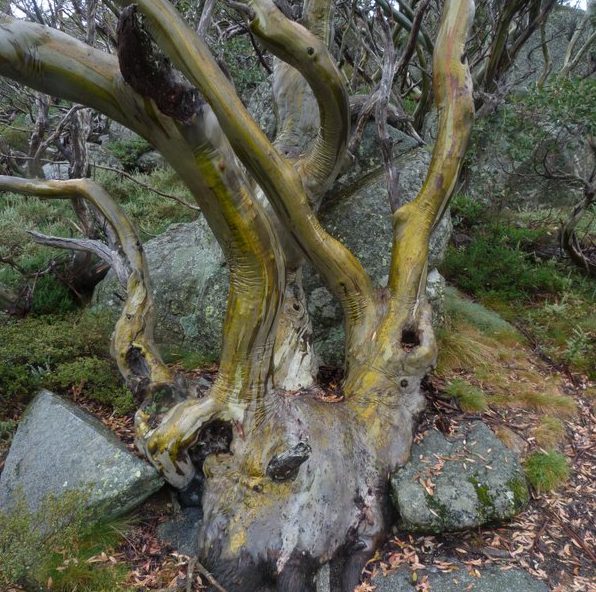
An old Snow Gum among the granite, its new summer bark gleaming in the rain. Photo: Ian Fraser.
Snow Gums are not only found in the high mountains – lower down they can sometimes be found forming a fringe around treeless frost hollows. There are remnant lower elevation Snow Gums around Canberra including a small copse with Natural Heritage listing below the Aranda bushland.
There are also scattered Snow Gums around the airport site. This, by the way, means that any ecologist could have told the airport planners that this is a sign that the site would be subject to heavy frosts and cold air pooling – and thus frequent and heavy fogs.
To fully appreciate the amazing adaptations of high country Snow Gums to their harsh environment of a short growing season and a long tough winter, it’s worth comparing their functions with those of their low elevation relations.

Snow Gum growing at low elevation near Canberra. Photo: Ian Fraser.
Each population – and they are the same species – functions most efficiently at the temperatures experienced where they live.
Brindabella Snow Gums do best at lower temperatures, Aranda Snow Gums at higher ones. But wait – there’s more. As the short summer progresses in the mountains, the Snow Gums up there change their preferences.
At the start of summer they work best at lower temperatures, but as summer progresses their preferred temperature rises, then falls again towards autumn, so that the temperature is always ‘just right’. Sort of a Snow Gum Camelot, and it means they can make the very most out of their limited opportunities.
There are plenty of reasons to love our Snow Gums – it is a truly beautiful habitat apart from anything else – and they are an excellent reason to go into the high parts of Namadgi National Park in summer. What are you doing next weekend?
Ian Fraser is a Canberra naturalist, conservationist and author. He has written on all aspects of natural history, advised the ACT government on biodiversity and published multiple guides to the region’s flora and fauna.
Original Article published by Ian Fraser on The RiotACT.







